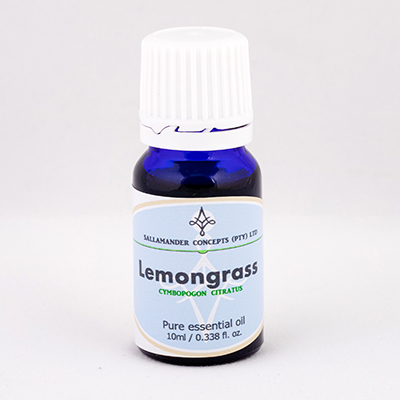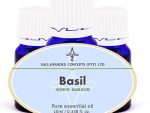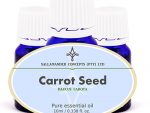Information on Lemongrass essential oil
Lemongrass essential oil is extracted from Cymbopogon citratus (also known as Andropogon citratus, A. schoenathus – West Indian, Madagascar or Guatemala lemongrass; Andropogon flexuosus, Cymbopogon flexuosus – East Indian, Cochin, British India or native lemongrass), of the Poaceae family.
Lemongrass Essential Oil is a fresh smelling oil that can be used with success for fighting jet lag, cellulite, revitalizing a tired body and mind.
Oil Properties
Lemongrass Essential Oil has a lemony, sweet smell and is dark yellow to amber and reddish in color, with a watery viscosity.
Origin
It is a perennial fast-growing aromatic grass, growing to about 1 meter (3 feet) high with long, thin leaves and grows wild in India. It produces a network of roots and rootlets that rapidly exhaust the soil. In India it is known as ‘choomana poolu’ and is also referred to as ‘Indian Verbena’ or ‘Indian Melissa oil’ and used in Ayurvedic medicine to help bring down fevers and treat infectious illnesses.
It is a valuable ingredient in perfumes and citrus-type soaps and is also an insect deterrent.
Extraction
Lemongrass oil is extracted from the fresh or partly dried leaves by steam distillation.
Chemical composition
Some of the main chemical components of lemongrass oil are Geranial, Neral, β-Myrcene, Geraniol, Limonene oxide, 1,8-Cineole
Precautions
Lemongrass Essential Oil will irritate a sensitive skin, so care should be taken. It should only be used on healthy, unbroken skin and at a low dilution rate. Lemongrass essential oil should be avoided in pregnancy – Geranial and Neral (Citral contained in the essential oil) may influence fetal development if ingested.
Lemongrass essential oil may influence medication taken for diabetes.
As with most essential oils, this essential oil should be kept in a dark and cool place and should be stored in an airtight glass bottle (Preferably in the fridge at a temperature of around 4° Celsius / 39° Fahrenheit).
Please read our page with heading: Safety with Essential Oils before using this oil.
We recommend the following book as an excellent resource regarding safety:
Essential Oil Safety: A Guide for Health Care Professionals by Robert Tisserand & Rodney Young (#ad)
Therapeutic properties
The therapeutic properties of lemongrass oil are analgesic, anti-depressant, antimicrobial. antipyretic, antiseptic, astringent, bactericidal, carminative, deodorant, diuretic, febrifuge, fungicidal, galactagogue, insecticidal, nervine, nervous system sedative and tonic.
Uses
Although some people may have an allergic reaction to Lemongrass Essential Oil, most people do not show an allergy when it is used in concentrations lower than 0.6%.
Lemongrass Essential Oil revitalizes the body and relieves the symptoms of jet lag, clears headaches and helps to combat nervous exhaustion and stress-related conditions.
It is a great overall tonic for the body and it boosts the parasympathetic nervous system, which is a boon when recovering from illness, as it also stimulates glandular secretions.
It is useful with respiratory infections such as sore throats, laryngitis and fever and helps prevent spreading of infectious diseases.
It is helpful with colitis, indigestion and gastroenteritis.
Lemongrass oil helps tone the muscles and tissue and relieves muscle pains by making the muscle more supple.
It helps with correcting poor circulation and as an insect repellent.
It also is used for clearing up oily skin and acne, as well as athlete’s foot.
It alleviates excessive perspiration.
Burners and vaporizers
In vapor therapy, Lemongrass oil can be used for nervousness and as an insect repellent.
It is also great to revive the mind when feeling lethargic and to energize as well as relieving fatigue.
Blended Massage Oil or in the Bath
Lemongrass Essential Oil can be used in blended massage oil or diluted in the bath to assist with cellulite, digestive problems, as a diuretic, for infections, nervousness, for over exerted ligaments and as a general tonic.
Blended in a Cream
When used in a lotion or a cream, it has value in clearing cellulite, as well as toning the skin, opening blocked pores and helping with acne.
The antiseptic properties are useful in treating athlete’s foot and other fungal infections.
On the skin
Adult:
Face: 0.25% to 0.6%
Body: 0.25% to 0.6%
Bath: 0.25% to 0.6%
3 to 24 months:
Do not use this essential oil – Avoid
3 to 6 years:
Face: Maximum of 0.25%
Body: Maximum of 0.25%
Bath: Maximum of 0.25%
6 to 15 years
Face: 0.25% to 0.5%
Body: 0.25% to 0.5%
Bath: 0.25% to 0.5%
Pregnancy
Do not use this essential oil. Avoid use on the skin – use as a room freshener or deodoriser is fine.
- When in doubt consult your doctor / medical professional before use.
- Most professionals and/or Aromatherapists will always err on the side of safety when giving advice regarding the use of essential oils and oleo resins during pregnancy.
- Quite a number of Aromatherapists advise that you should avoid all essential oils completely while pregnant, specifically during the first trimester. This is a very safe approach but may not be necessary at all.
Diffusers and Vaporisers
4 to 8 drops
General:
- When using for the first time – Always use the lowest dilution rate and build up slowly to the maximum. Stop using all essential oils on the skin if irritation or allergy occurs.
- Any advice or instruction received from a medical professional ALWAYS supersedes recommendations or advice found on this website. When in doubt consult your doctor / medical professional.
Summary
Lemongrass Essential Oil has great benefits as a muscle and skin toner, and revitalizes the body and mind and helps with infections.
Blends
Although essential oils blend well with one another, lemongrass oil blends particularly well with Basil, Cedarwood, Coriander, Geranium, Jasmine, Lavender and Tea tree.





